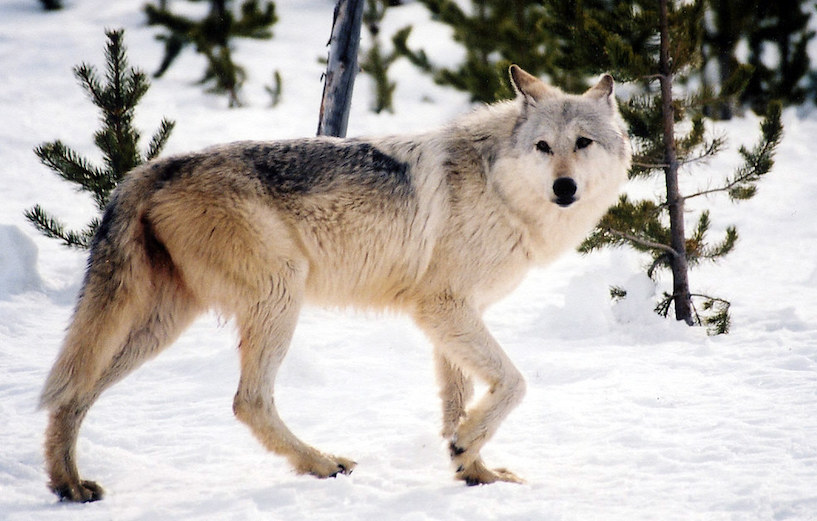Photo: Fish and Wildlife Service
Wolves have long stirred strong emotions in this country and still do. The idea of bringing wolves back to Colorado generates passionate support as well as die-hard opposition. Yet from an ecological standpoint, wolves belong here. And the science is clear that we can manage their introduction effectively. San Juan Citizens Alliance has spent over 20 years advocating for habitat protection in the San Juan Mountains. This year we joined the Rocky Mountain Wolf Project, a coalition that is working to put a ballot initiative on the 2020 Colorado ballot. If passed, Colorado Parks and Wildlife will be directed to reintroduce wolves to the western slope by the end of 2023.
Brief History
Gray wolves once thrived throughout North America, from coast to coast and from Mexico all the way to the Arctic. They fed on bison, elk, and deer as well as smaller mammals like rabbits and rodents. But when hunters drove down the large mammal populations on which they depended, wolves turned more to livestock. This, of course, sealed their fate. The remaining wolves were hunted down by humans – shot, poisoned, and trapped until the 1940’s when none remained in Colorado. This played out throughout much of the country, in some areas being eliminated much sooner.
Reintroduction
In the 1960’s, gray wolves earned federal protections under what eventually became the Endangered Species Act (ESA). Under the ESA, recovery of the species was mandated. In 1995, after 20 years of effort, 31 gray wolves from Canada were relocated to Yellowstone National Park and central Idaho. A main fear was that wolves would prey primarily on livestock. They did so much less than feared however.
5 Reasons to Bring Wolves Back to Colorado
1. Wolves perform important ecological functions:
Wolves’ hunting behavior causes changes in prey behavior, which can create positive change in environmental conditions. We know this because we’ve seen it. Nearly 25 years after wolves were introduced to Yellowstone, we’ve seen transformational changes to the ecosystem that demonstrate just how critical wolves are. Free from their wolf predators, deer and elk populations had boomed for many decades, decimating willow, aspen and cottonwoods. The river banks eroded, beavers and songbirds birds struggled, and even scavengers were at a loss.
Once the wolves were reintroduced, they not only kept populations of grazers in check, but dispersed them, forcing them to move around the landscape more and distributing their impact. Trees and shrubs thrived again, stabilizing the soil and riverbanks, but also providing homes for birds and food for beavers. Scavengers found more leftover food from wolf kills. Beaver dams stored more water and provided habitat for numerous other species. Learn More
2. Expanding wolves’ range enhances genetic resiliency; Colorado is the “missing link.”
Wolves occupy about 10% of their former range. They once moved across all of western North America and had the potential to breed with other wolves. The small population of Mexican gray wolves in New Mexico and Arizona would benefit from the addition of genetic diversity from wolves moving in from the north. Similarly, the ability of wolves from the northern Rockies to move south and of wolves in the southern Rockies to move north would help ensure the genetic health of both populations. Restoring wolves to Colorado is the best way to rebuild this genetic interchange.
3. The public wants it.
A February 2019 survey found that 67% of Colorado voters support wolf restoration. That includes 61% of voters on the western slope, where wolves would be . Further, 64% of voters in farm and ranch households and 68% of voters in households with hunters support restoration. This level of support is nearly identical to that found in earlier surveys, indicating that restoring wolves is aligned with the basic values held by Colorado voters.
4. Intentional reintroduction allows management flexibility.
Due to the legal requirements of the federal Endangered Species Act (ESA), there would be more management flexibility if wolves were intentionally reintroduced than if wild wolves naturally moved into Colorado from their current ranges north and south of the state. Currently (May 2019) any wolves in Colorado are listed as “endangered” under the ESA. Wolves reintroduced into the state would almost certainly be managed under an “experimental nonessential” designation, which would relax ESA restrictions, allowing for actions such as harassing or removing wolves that attack livestock. This designation can help with acceptance of restoration by livestock producers, local government officials, and others with concerns about wolf presence.
5. It’s the right thing to do.
Wolves were part of our original wildlife heritage. We are responsible for their demise, but we now have the opportunity to bring them back. We can do it in a way that respects and maintains ranching and hunting. While biologists sometimes seem quite certain about the functioning of ecosystems, the truth is that there is a lot that’s not known. One thing we know with no doubt is that wolves and their prey lived together for millennia and were continually adapting to each other. Our ignorance about all of the effects of wolves on ecosystems argues for a cautious approach. Aldo Leopold, the father of modern wildlife management wrote “…To keep every cog and wheel is the first precaution of intelligent tinkering.” We removed an important cog, and now we can restore it.




Please provide the source of the numbers for the 2019 Februaury survey in which the majority of Coloradans are in favor of restoring wolves.
Sorry, I meant to do that! I just linked to the executive summary from the blog, but it’s from Lake Research Partners and New Bridge Strategy. The Executive Summary Memo, March 12 2019 is linked.
Strange…I know several ranchers and many hunters in CO and none—absolutely none—want wolves. Wolves will reap havoc on livestock and the ungulate populations. Do some more research and talk to wildlife biologists and game managers on wolves.
Management flexibility? Really? Anti-hunting groups continue to tie the government’s hands in opening wolf hunting for management for years through non-stop legal suits.
Part of the ecosystem….I agree, at one time this was true. So were grizzlies. Are we to reintroduce them too? The landscape isn’t being run ragged largely due to the excellent work of biologist, game managers, hunters, and other conservationist.
The DNA link is pure BS. Absolutely laughable! Wolves are apex predators who are extremely competitive and won’t stand for any sort of territorial or food competition. As such, the Mexican wolf will—an actual struggling endangered species—won’t have a chance. Yes, grey wolves will kill Mexican wolves.
Mr. Anderson:
I actually am a wildlife biologist and I wrote the post you responded to. As a bit of background, I worked for over 25 years for the Colorado Division of Wildlife (before it combined with Parks) and one of my responsibilities was the management of the process that produced the Findings and Recommendations for Managing Wolves that Migrate into Colorado report (https://cpw.state.co.us/Documents/WildlifeSpecies/SpeciesOfConcern/Wolf/recomendations.pdf )
I was also a member of the Mexican wolf recovery team in 2002/2003, so I’m familiar with that situation. Overall, I don’t claim to be a wolf “expert” like David Mech or Rolf Peterson but I do know a lot more about wolves than most wildlife biologists who haven’t specifically worked on wolves.
In response to your comments:
1. Ranchers wanting wolves: Your point is well taken. I don’t have the details of the survey that was done, but my interpretation of the question is that folks were asked if they were part of a ranching or farming family and that was cross referenced with their response to whether or not they supported wolf restoration. You can interpret that in multiple ways. There are, however, ranchers in currently occupied wolf range in Montana and California who, while not preferring to have wolves, have learned to live with them and consider them part of doing business.
2. Wreaking havoc on livestock and wildlife: That’s not what’s happening in occupied wolf range. Some ranchers have suffered losses that are difficult to deal with. In Montana, most elk hunting units in occupied wolf range are at or above their objective and Montana Game Fish and Parks is trying to reduce elk populations. See: http://fwp.mt.gov/fishAndWildlife/management/elk/ and find the 2018 map.
3. Management Flexibility: Wolves can be restored to Colorado under the Endangered Species Act’s “experimental non-essential” status, which allows much more flexibility than if they are protected under ESA Endangered status. That’s how it’s been done in other states.
4. Part of the Ecosystem: Grizzlies belong, too, but I wouldn’t advocate for returning them because they truly can be dangerous to humans using backcountry. That’s not true of wolves. I’m not sure what you mean by “run ragged” but I do agree that state wildlife managers and federal land managers are doing a very good job.
5. DNA: I’m not sure I really understand your point. All wolves are the same species (Canis lupus) and the Mexican wolf is a sub-species. It’s more likely that restored wolves would breed with Mexican wolves than killing them, and that is one of the objectives of restoration into the central Rockies, because it would allow for genetic interchange from Alaska to central Mexico, providing more ability to respond to habitat changes. Mexican wolves are indeed having a rough go of it, and the reasons are complex, and both political and biological.
If you’d like to discuss this more, I’d be happy to buy you a cup of coffee and chat sometime.
Gary Skiba
Mr. Anderson:
I didn’t address the hunter portion of your comment. I’m a hunter, I want to see wolves restored. I’m sure there are others, including individuals who want to hunt wolves.
Mr. Anderson, where did you go?? Or did you only want to broadcast your long-held beliefs without challenge, rather than engage with an expert of Mr. Skiba’s caliber and experience. Shocking.
– Colorado hunter who greatly prefers wolves to people who are willing to shrug off science whenever it conflicts with their preconceived notions.
I used to have a 90% wolf husky mix as a pet someone gave me and I will tell you they are killing machines. If I ever let it out to roam he would immediately run for however miles it took to chase cattle, wildlife, or whatever until something was dead, regardless of how much you fed him. Would do it for sport, not just to eat. Neighbor’s turkeys, chickens, cats, whatever, and not just one chicken to eat, but all of them. I really don’t think the advantages are worth the price we will pay having packs of them on the loose. Mountain lions can be trouble too, but to a much less degree and tolerable.
I too had a mixed wolf-dog; Being predatory has to do with being a dog period. And a bored pet is always looking for something to do. If your pet, wolf or not, is always hungry then that’s who they are. My Malmute-wolf used to protect my child if she thought they were in danger – her mother instincts were even for a crying baby. Hardly a killing machine or that sketchy guy who came to visit my boyfriend would have gotten more than an earfull.
Ken:
Wolves occasionally, but very rarely, show what is known as “surplus killing” behavior. As it is rare, it’s not completely understood, but appears to happen when prey are concentrated and vulnerable for some reason, such as a group of elk in deep snow. Renowned wolf biologist David Mech has only seen such behavior twice in over 30 years of studying wolves. They kill to survive, and they focus almost exclusively on ungulates, with elk being the dominant prey item where they are available, or deer or moose where they are what’s available. In Yellowstone, elk make up 80+% (varies by year) of wolf kills with bison, deer and moose making up the rest of their kills. Smaller prey (rabbits, squirrels, mice, etc.) are sometimes (but rarely) killed. If ungulates are around, that’s what they prey on.
A domesticated animal, such as your wolf husky mix, displays much different behavior, partly because they get enough food at home and because they are habituated to human presence. They are not killing to eat, as wolves almost always are. I had a Labrador once that was coming out of the door of the chicken coop with the 3rd dead chicken, and I’m pretty sure she would have continued on the remaining dozen or so if I hadn’t shown up.
Bottom line is the behavior you describe is just not seen in wild wolves. They are not killing to kill, and when preying on large ungulates, they are constantly in danger of being injured or killed themselves, so hunting isn’t something they engage in just to kill.
If you’d like to talk about this more, let me know.
Anyone wanting to dive deeper into this issue should search “Colorado State CHCC” and spend some time exploring the excellent FAQs and fact sheets in the People and Predator Series that the scientists at Colorado State have created regarding restoring wolves to Colorado. You’ll be a better informed voter for having done so.